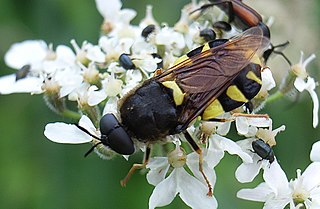The British Entomological and Natural History Society or BENHS is a British entomological society. It is based at Dinton Pastures Country Park in Reading.

The Chamaemyiidae are a small family of acalyptrate flies with less than 200 species described worldwide. The larvae of these small flies are active and predatory and are often used for biological control of aphids, scale insects, and similar pests. Chamaemyiid fossils are poorly represented in amber deposits, but a few examples are known from the Eocene epoch onwards.

Syrphus is a genus of hoverflies. It can be distinguished from other genera of the tribe Syrphini because it is the only genus that has long hairs on the upper surface of the lower lobe of the calypter.

Platycheirus clypeatus is a species of hoverfly. It is found across the Palearctic and in the Nearctic. The larvae feed on aphids. Adults are usually found on the edges of woodland or scrub, heath or along hedgerows where they visit a wide range of flowers.

Stratiomys chamaeleon, the clubbed general, is a European species of soldier fly.

Dasysyrphus is a genus of hoverflies.

Platycheirus is a large genus of hoverflies. They are also called sedgesitters.

Sphaerophoria is a genus of hoverflies.

Orthonevra is a genus of hoverflies.

Melangyna cincta is a European species of hoverfly. This species has a muddled taxonomic history. Stubbs & Falk treat it as a member of the genus Melangyna. Other sources place it in Meligramma or Fagisyrphus.

Parasyrphus vittiger is a species of hoverfly, from the family Syrphidae, in the order Diptera.

Platycheirus angustatus is a species of hoverfly. It is found in many parts of the Palearctic, and in the Nearctic.
Platycheirus europaeus is a Palearctic species of hoverfly. It is found in many parts of Europe and eastern Asiatic Russia The habitat is brook floodplains and wet flushes in montane grassland and beside streams or flushes in forest in the Carpinus and Quercus zone up into the Fagus and Picea/ Pinus zone. Flies among grasses from May to August. Flowers visited include Graminae and Cyperaceae, Ranunculus, Taraxacum.
Platycheirus ramsaerensis is a Palearctic species of hoverfly. It is found along the parts of northern Europe that face the Atlantic. It is a member of the Platycheirus clypeatus group

Melangyna umbellatarum is a Holarctic species of hoverfly.

Megasyrphus is a genus of hoverflies in the subfamily Syrphinae. It was formally a subgenus of Eriozona.
Leucostoma anthracinum is a species of fly in the family Tachinidae, found in Europe.
Dasysyrphus pauxillus is a North American and European species of hoverfly.

Brachyopa insensilis is a Palearctic species of hoverflies.













